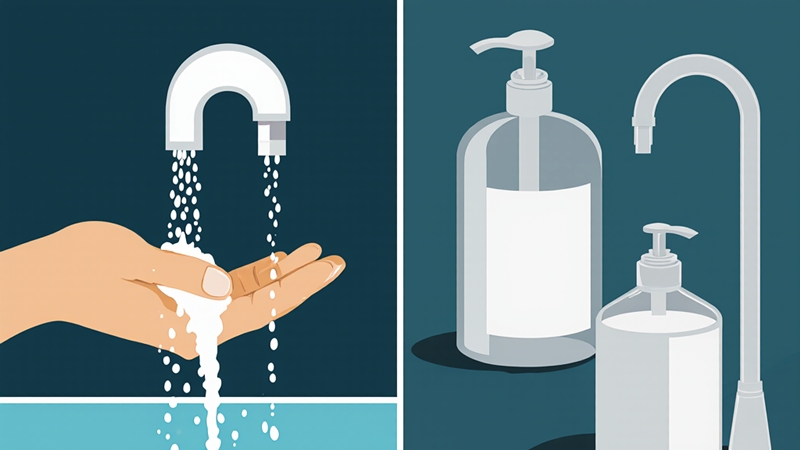Uncategorized
The Difference Between Hand Washing and Hand Sanitizing
Introduction
Keeping our hands clean is one of the simplest and most effective ways to protect ourselves from germs, bacteria, and viruses. But with so many products and methods available, many people wonder about the difference between hand washing and hand sanitizing. Are they equally effective? When should you use soap and water, and when is hand sanitizer enough?
In this blog, we’ll explore the difference between these two hygiene practices, how each one works, and when to use them to stay safe and healthy.
Understanding the Basics
Before diving into the difference, let’s first understand what each method means.
What Is Hand Washing?
Hand washing simply means cleaning your hands with soap and water. The mechanical action of rubbing your hands together helps remove dirt, grease, and microbes from the skin. Rinsing with water then washes these unwanted particles away.
What Is Hand Sanitizing?
Hand sanitizing, on the other hand, involves using a gel, foam, or liquid product that usually contains alcohol (most commonly 60–70% ethanol or isopropanol). Instead of rinsing, the sanitizer stays on your hands and kills many germs on contact.
Both methods aim to clean your hands, but the difference lies in how they work and when they are most effective.
The Main Difference: Soap vs. Alcohol
The key difference between hand washing and hand sanitizing comes from the main cleaning agents they use: soap versus alcohol.
- Soap and Water: Soap molecules break down oils and dirt on your skin. They also trap germs so they can be rinsed away with water.
- Hand Sanitizer: The alcohol in sanitizers kills many germs by breaking down their outer membranes or proteins, effectively destroying them.
In short, washing physically removes germs, while sanitizing kills many (but not all) of them.
Effectiveness Against Germs
Here’s another major difference between the two methods — their effectiveness in different situations.
Hand Washing
- Works against all kinds of germs, including viruses, bacteria, and parasites.
- Removes visible dirt, grease, and chemicals.
- Reduces the risk of foodborne illnesses.
- Recommended after using the bathroom, handling raw meat, or touching dirty surfaces.
Hand Sanitizing
- Effective only against certain germs, mostly those that are sensitive to alcohol.
- Does not remove dirt or grease.
- Useful when soap and water are not available, such as while traveling or in public places.
So, the difference in effectiveness is clear: washing is more thorough, while sanitizing is more convenient.
When to Wash and When to Sanitize
Knowing when to wash and when to sanitize can make a big difference in keeping your hands truly clean.
Wash Your Hands When:
- They are visibly dirty or greasy.
- You’ve been to the bathroom.
- You’ve handled food, especially raw meat or eggs.
- You’ve touched animals or garbage.
- You’ve been around someone who is sick.

Use Hand Sanitizer When:
- You’re outdoors or traveling and don’t have access to water.
- You’ve touched commonly used surfaces like doorknobs or shopping carts.
- You want a quick clean between tasks.
Both are useful, but their proper use depends on the situation. Recognizing this difference helps you make smarter hygiene choices.
The Right Way to Wash and Sanitize
Even though both methods clean your hands, technique matters. The difference between clean and unclean hands often depends on how you do it.
How to Wash Properly:
- Wet your hands with clean running water.
- Apply soap and lather well.
- Scrub all areas — palms, backs of hands, between fingers, and under nails — for at least 20 seconds.
- Rinse thoroughly.
- Dry with a clean towel or air dry.
How to Sanitize Properly:
- Apply a coin-sized amount of sanitizer to one palm.
- Rub your hands together, covering all surfaces.
- Continue rubbing until your hands feel dry (about 20 seconds).
- Do not wipe or rinse your hands afterward.
Doing these steps correctly makes a big difference in how clean your hands actually get.
Limitations and Misconceptions
Many people believe hand sanitizers can replace soap completely, but that’s not true. The difference in results becomes obvious when your hands are visibly dirty or greasy — sanitizers simply don’t work well in such cases.
Also, some sanitizers may not contain enough alcohol or may include fragrances and moisturizers that reduce their germ-killing ability. Always check that your sanitizer has at least 60% alcohol for proper effectiveness.
Which One Is Better?
There isn’t a single winner — both methods have their own strengths. The difference lies in where and how you use them:
- Hand washing is the best method when soap and water are available.
- Hand sanitizing is ideal for moments when you’re on the go and need quick protection.
The best approach is to combine both: wash your hands whenever possible, and use sanitizer as a backup option.
Conclusion
Understanding the difference between hand washing and hand sanitizing helps you make smarter decisions about hygiene in daily life. Washing removes dirt, grease, and all kinds of germs, while sanitizing kills most germs quickly when water isn’t available.
In simple terms:
- Wash when you can.
- Sanitize when you must.
Both methods play a vital role in keeping you and those around you safe. By knowing this difference and using each method correctly, you can greatly reduce your risk of illness and enjoy a healthier, cleaner lifestyle — wherever you are.
You can easily find more of our blogs on Sanixway blog section!

